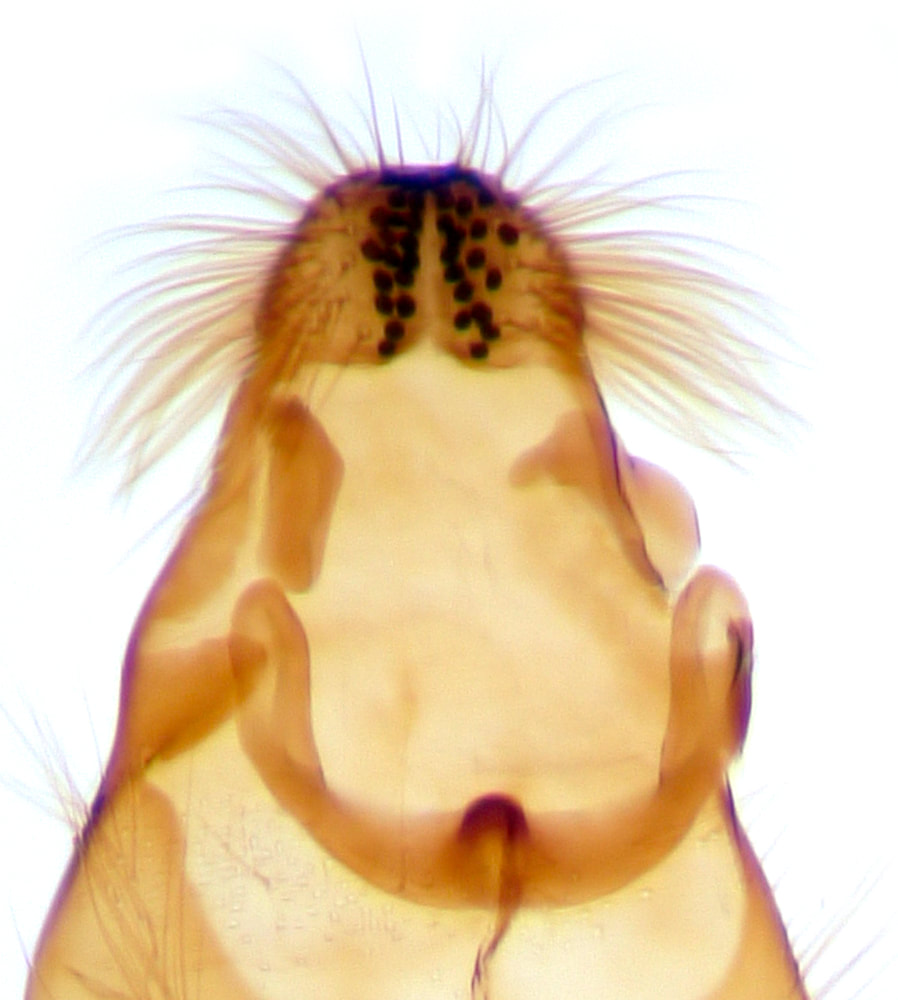Anacampsis |
Generic features: Antenna without pecten; Labial palps long and slender; Forewing elongate, termen oblique, no scale tufts; Hindwing broader than forewing, apex and tornus rounded, no emargination of termen
Male genitalia: uncus with a group of black pegs ventrally; aedeagus curved, at least as long as armature
Male genitalia: uncus with a group of black pegs ventrally; aedeagus curved, at least as long as armature
ID: A.temerella is grey to blackish with a black subterminal fascia and is confined to the NW coasts of England and Wales. A.populella and A.blattariella are very similar to each other and their forewing pattern is also similar to some Bryotropha species. Bryotropha species mostly have a furrowed brush of scales on S2 of the labial palps (more slender and without the furrowed brush in Anacampsis), and a single-bristle pecten on the antennal scape (no pecten in Anacamspsis). However B.galbanella and B.boreella both lack the furrowed brush and the pecten bristle.
ID to genus based on male genitalia: A8 forming a complete ring; uncus not lobed; valvae symmetrical; gnathos present, simple; apex of aedeagus simple; uncus with a group of black pegs ventrally; aedeagus curved and at least as long as armature. Aproaerema also shows black pegs on the uncus but has a straight aedeagus shorter than the armature.
A.populella/blattariella are only reliably separable by genital examination. However, all the differences described in MBGBI4.2 are comparative, which makes it difficult to use it to identify a specimen of one species without access to reference material of the other species.
ID to genus based on male genitalia: A8 forming a complete ring; uncus not lobed; valvae symmetrical; gnathos present, simple; apex of aedeagus simple; uncus with a group of black pegs ventrally; aedeagus curved and at least as long as armature. Aproaerema also shows black pegs on the uncus but has a straight aedeagus shorter than the armature.
A.populella/blattariella are only reliably separable by genital examination. However, all the differences described in MBGBI4.2 are comparative, which makes it difficult to use it to identify a specimen of one species without access to reference material of the other species.
Male genitalia
|
1. The gnathos of of A.populella is noticeably more robust than that of A.blattariella.
2. The uncus of A.blattariella has broadly rounded lateral lobes with a studded central section produced a little posteriorly, but orientated more in the transverse than longitudinal axis; while in A.populella the uncus lacks obvious lateral lobes and the studded section is paramedian, in the long axis of the abdomen. 3. The valvae of A.blattariella appear longer than those of A.populella. (In my material the ratio of valval length: valval width at ~½ is 6 vs 5; but I have not adequately assessed the variability within each species to be sure this would provide a reliable distinction). |
|
Female genitalia: Differences between A.populella/blattariella are again described in relative terms in MBGBI4.2: A.populella - "the apophyses are shorter, the ostium plate less ovate and the apical projection less prominent" (it should be noted that what is described as the 'ostium plate' is actually a sclerotisation of the dorsal plate of S8). In the drawings in MBGBI4.2 the ovipositors are drawn with greater separation between the papilles anales and the sterigma but the apophyses are only drawn marginally longer in A.blattariella. The images of these species at dissection group do not show the whole ovipositor so this feature cannot be checked. Which has the more "ovate' ostial plate is a matter of opinion. The crucial difference between the species is in the shape of the posterior margin of the dorsal plate of S8 which is broadly rounded with a small apical pimple in A.populella and more conical with a distinct apical nipple in A.blattariella.
|
Page published ~2013; Male genital section rewritten with new images 16/12/2023







